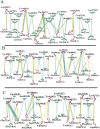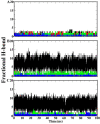In silico investigation of critical binding pattern in SARS-CoV-2 spike protein with angiotensin-converting enzyme 2
- PMID: 33767306
- PMCID: PMC7994905
- DOI: 10.1038/s41598-021-86380-2
In silico investigation of critical binding pattern in SARS-CoV-2 spike protein with angiotensin-converting enzyme 2
Abstract
Severe acute respiratory syndrome coronavirus-2 (SARS-CoV-2) is a newly-discovered coronavirus and responsible for the spread of coronavirus disease 2019 (COVID-19). SARS-CoV-2 infected millions of people in the world and immediately became a pandemic in March 2020. SARS-CoV-2 belongs to the beta-coronavirus genus of the large family of Coronaviridae. It is now known that its surface spike glycoprotein binds to the angiotensin-converting enzyme-2 (ACE2), which is expressed on the lung epithelial cells, mediates the fusion of the cellular and viral membranes, and facilitates the entry of viral genome to the host cell. Therefore, blocking the virus-cell interaction could be a potential target for the prevention of viral infection. The binding of SARS-CoV-2 to ACE2 is a protein-protein interaction, and so, analyzing the structure of the spike glycoprotein of SARS-CoV-2 and its underlying mechanism to bind the host cell receptor would be useful for the management and treatment of COVID-19. In this study, we performed comparative in silico studies to deeply understand the structural and functional details of the interaction between the spike glycoprotein of SARS-CoV-2 and its cognate cellular receptor ACE2. According to our results, the affinity of the ACE2 receptor for SARS-CoV-2 was higher than SARS-CoV. According to the free energy decomposition of the spike glycoprotein-ACE2 complex, we found critical points in three areas which are responsible for the increased binding affinity of SARS-CoV-2 compared with SARS-CoV. These mutations occurred at the receptor-binding domain of the spike glycoprotein that play an essential role in the increasing the affinity of coronavirus to ACE2. For instance, mutations Pro462Ala and Leu472Phe resulted in the altered binding energy from - 2 kcal mol-1 in SARS-COV to - 6 kcal mol-1 in SARS-COV-2. The results demonstrated that some mutations in the receptor-binding motif could be considered as a hot-point for designing potential drugs to inhibit the interaction between the spike glycoprotein and ACE2.
Conflict of interest statement
The authors declare no competing interests.
Figures






Similar articles
-
V367F Mutation in SARS-CoV-2 Spike RBD Emerging during the Early Transmission Phase Enhances Viral Infectivity through Increased Human ACE2 Receptor Binding Affinity.J Virol. 2021 Jul 26;95(16):e0061721. doi: 10.1128/JVI.00617-21. Epub 2021 Jul 26. J Virol. 2021. PMID: 34105996 Free PMC article.
-
Shedding Light on the Inhibitory Mechanisms of SARS-CoV-1/CoV-2 Spike Proteins by ACE2-Designed Peptides.J Chem Inf Model. 2021 Mar 22;61(3):1226-1243. doi: 10.1021/acs.jcim.0c01320. Epub 2021 Feb 23. J Chem Inf Model. 2021. PMID: 33619962
-
Multidisciplinary Approaches Identify Compounds that Bind to Human ACE2 or SARS-CoV-2 Spike Protein as Candidates to Block SARS-CoV-2-ACE2 Receptor Interactions.mBio. 2021 Mar 30;12(2):e03681-20. doi: 10.1128/mBio.03681-20. mBio. 2021. PMID: 33785634 Free PMC article.
-
The expression of hACE2 receptor protein and its involvement in SARS-CoV-2 entry, pathogenesis, and its application as potential therapeutic target.Tumour Biol. 2021;43(1):177-196. doi: 10.3233/TUB-200084. Tumour Biol. 2021. PMID: 34420993 Review.
-
Potential therapeutic approaches for the early entry of SARS-CoV-2 by interrupting the interaction between the spike protein on SARS-CoV-2 and angiotensin-converting enzyme 2 (ACE2).Biochem Pharmacol. 2021 Oct;192:114724. doi: 10.1016/j.bcp.2021.114724. Epub 2021 Aug 8. Biochem Pharmacol. 2021. PMID: 34371003 Free PMC article. Review.
Cited by
-
In Silico Evaluation of Natural Flavonoids as a Potential Inhibitor of Coronavirus Disease.Molecules. 2022 Sep 27;27(19):6374. doi: 10.3390/molecules27196374. Molecules. 2022. PMID: 36234910 Free PMC article. Review.
-
Bionics design of affinity peptide inhibitors for SARS-CoV-2 RBD to block SARS-CoV-2 RBD-ACE2 interactions.Heliyon. 2023 Jan;9(1):e12890. doi: 10.1016/j.heliyon.2023.e12890. Epub 2023 Jan 13. Heliyon. 2023. PMID: 36686609 Free PMC article.
-
A comparative study of receptor interactions between SARS-CoV and SARS-CoV-2 from molecular modeling.J Mol Model. 2022 Sep 8;28(10):305. doi: 10.1007/s00894-022-05231-7. J Mol Model. 2022. PMID: 36074206 Free PMC article.
-
Binding affinity between coronavirus spike protein and human ACE2 receptor.Comput Struct Biotechnol J. 2024 Jan 17;23:759-770. doi: 10.1016/j.csbj.2024.01.009. eCollection 2024 Dec. Comput Struct Biotechnol J. 2024. PMID: 38304547 Free PMC article. Review.
-
Molecular recognition of SARS-CoV-2 spike protein with three essential partners: exploring possible immune escape mechanisms of viral mutants.J Mol Model. 2023 Mar 24;29(4):109. doi: 10.1007/s00894-023-05509-4. J Mol Model. 2023. PMID: 36964244 Free PMC article.
References
-
- Payne S. Family coronaviridae. Viruses. 2017 doi: 10.1016/B978-0-12-803109-4.00017-9. - DOI
-
- Sahin AR, et al. Novel coronavirus (COVID-19) outbreak: a review of the current literature. EJMO. 2020;4:1–7.
MeSH terms
Substances
LinkOut - more resources
Full Text Sources
Other Literature Sources
Miscellaneous

